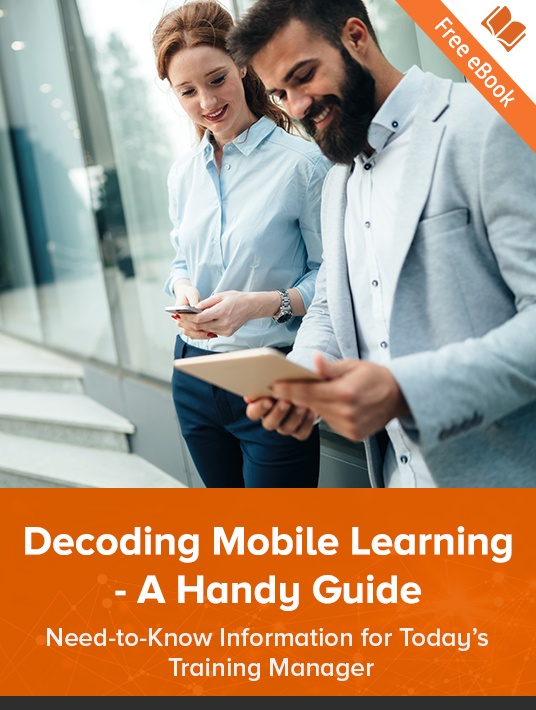Popular Delivery Formats Used For Corporate Mobile Learning
Screen size, navigation, and content volume are the fundamental influencers of mobile learning design, alongside the target audience and their current knowledge levels. Mobiles have become an indispensable part of the organizational learning strategy, as more and more learners prefer to access learning on the go. In contrast to traditional learning, mobile learning offers significant benefits to learners and organizations alike. It offers just-in-time support and also allows for learning on the device of choice.

The ceaseless proliferation of smartphones and tablets has opened a staggering environment for development. Like all industries, the eLearning community must also gear up for mobile learning, or 'mLearning'. Here, we’ll take a look at the most popular formats used for delivering corporate mobile learning.
1. eBooks
One of the most straightforward approaches to present learning content on a mobile platform is through eBooks. An eBook has textual information supported by visuals and multimedia resources such as illustrations, videos, audio, and hyperlinks. An eBook can be customized according to the size and resolution of the gadget it is being viewed on. They can be used to provide short, comprehensive coverage of a topic.
For example, consider a training program for Sales reps. While an eCourse can cover the product features in detail, an eBook can offer a comprehensive comparison with leading competitors – including pricing options and product specs. Since these assets can be accessed on mobiles, learners have access to information at the moment of need.
2. Videos
Videos are widely used for corporate mobile learning. Short explainer videos and DIY videos tend to interest the tenacious workforce. With millennial learners wanting to utilize videos to learn and accessing them on cell phones, videos delivered through the mobile platform can be the intense duo to train your workers, particularly Millennials. Mobile learning meets employees’ requirement for portability, and videos delivered through mobiles give them the information they look for, whenever needed, in the preferred format.
Videos are the perfect medium to convey quick tutorials and how-to steps; they are effective at teaching new aptitudes too. Videos encourage critical thinking; videos as stories can present sensitive information, introduce contextual studies, and talk about real incidents.
Consider a video on the right body language while convincing customers or one on the 3-step operation process. Imagine the impact on performance when learners access these videos just before tackling the task at hand!
3. Microlearning Modules
Microlearning modules as we are aware, are short learning modules or learning chunks that focus on covering one learning point comprehensively. This information will enable learners to carry out the task at hand, enhance their abilities, or improve skills on the job. As micro nuggets are easily accessible and digestible, organizations and learners opt to go the microlearning way.
Micro resources can be delivered through mobiles in several engaging formats such as games, videos, podcasts, infographics, or job-aids. Short chunks of information delivered through mobile devices connect with learners and help them understand better.
4. Flashcards
Flashcards are the go-to tools for instructors and trainers, when they need to avert cognitive overload and create a memorable learning experience. Flashcards have the ability to influence the eLearning experience, making it intriguing for learners of any age. They can cover key terms, definitions, provide examples, present contrasting elements, and are easy to access on mobiles.
Flashcards offer major benefits such as engaging attention and activating knowledge recall. Flashcards can be used as performance support tools and job-aids that help learners learn and retain accurate knowledge.
For example, imagine a medical rep who has to convince a doctor to prescribe his drug. When waiting for the doctor, he can flip through the cards on his smartphone and reinforce his knowledge about the adverse effects and drug trials.
5. Infographics
Infographics are visually appealing and make large volumes of information easy to read and comprehend. Infographics can be used to visually represent any information that your learners should be aware of. For instance, in process training, you can use an infographic to visually explain the procedure to be followed.
Consider an infographic on the dress code policy. New hires can refer it when in doubt. Let’s not forget, when there is minimal text and more graphics, learners can digest information with ease. Infographics are shareable and capture the attention of learners, all while keeping them engaged.
Final Word
As the use of mobile learning in corporate training is setting down deep roots, designing assets that hold learners’ attention and best suit the purpose of training will yield results. Mobile learning has numerous advantages, and it answers learners’ necessity for flexibility and access. Ensure you design courses that are apt for mobiles and work effectively.
If you want to learn more about the potential of mobile learning, download the eBook Decoding Mobile Learning - A Handy Guide.

